IDF uses AI to strike over 11,000 terror target in Gaza since October 7
The IDF’s intelligence target bank efforts have led to striking over 11,000 targets in Gaza since the war started on October 7, a senior IDF intelligence official said on Thursday.
Further, the senior official said that on the first day of the invasion last week, the highly advanced artificial intelligence (AI) led target bank helped IDF fighters target and destroy 150 tunnel targets in one day.
Unlike in the past, 90% of the targets hit due to the mix of efforts by the AI and hundreds of IDF intelligence officials are being generated and struck in real-time.
While IDF intelligence has been using forms of AI for even longer, the program took a quantum leap forward in 2019.
Despite that leap forward, the senior intelligence official said that this is the first time that the AI target bank unit has been used for an all-out ground invasion, with numerous units maneuvering in hostile urban areas simultaneously.

In the past, the intelligence unit had helped facilitate numerous rounds of airstrike-led conflicts with Gaza.
This intelligence AI unit has been critical to the early success of the IDF in fleshing out the vast majority of Hamas’s ambushes before they are sprung on maneuvering invading IDF ground forces.
The unit has had to adjust in real time to learning new Hamas tactics, including altering tactics where it has found that past tactics for destroying tunnels, such as in the May 2021 Gaza conflict, were only partially successful.
The senior official would not reveal what tactical changes were made, but confirmed that adjustments being made are leading to greater success in more permanently destroying Gazan tunnels.
In spring of this year, the Jerusalem Post visited the IDF’s new secret intelligence target bank headquarters and was given a deep and detailed debriefing about how the elite unit functions in 2023 as well as the revolutionary changes that have taken place dating back to 2019 and including the May 2021 conflict with Hamas.
The presentation was eye-opening and portrayed the IDF as shattering barriers and records with astounding efficiency that should set any enemy threatening Israel on its heels.
From the start, it is critical to understand that when speaking about set targets in peacetime that enter the bank as opposed to moving targets in wartime, the reference is usually to Hamas or Hezbollah command centers, lookout or spying stations and weapons manufacturing or storage locations.
Targets in the “bank” are not just inserted weeks or years before and relied on indefinitely. There is always a near-term or current double-checking process to make sure the military object is still at the specified location and is still of a similar character – meaning that no new civilians have ventured into the line of fire.
IDF intelligence used to have hundreds of targets in its Lebanon target bank; by spring of this year, it had thousands. In addition, now the IDF can double or triple the number of targets it can find in real-time.
This is hugely significant. For the last decade or so of Gaza conflicts, the IDF had a target bank that it built during peacetime.
But once a conflict broke out, the targets to hit dropped substantially either because the IDF hit most high-quality targets in the early days, or because many Hamas and Islamic Jihad personnel and weapons were moved from their hiding spots during the early days of a conflict.
Certainly, there were new targets, especially Gaza forces that revealed themselves in order to fire rockets. But new hiding spots of senior officials and new command centers required much more new intelligence.
The numbers tell the same story when one dives down to the weekly work by the IDF intelligence target bank unit.
Ten times the efficiency
If, before 2019 and in earlier years, the unit would find and approve 10 targets in 10 days of work, it now finds and approves around 100 targets for every 10 days of work.
This leap forward not only changes the volume and pace of targets, but alters the very category of targets that IDF intelligence can seek to address. If before, a deep dive of resources and manpower could only be invested for top-tier targets, now there are enough resources to invest substantially in locating and targeting even lower-level targets.
For example, before, no one would follow up on a vague piece of intelligence to locate a lower-level Hamas terrorist in Gaza who can be found near a partially concealed and small “green and orange wall.” The chances of finding him were so small and resources were so limited that it just would not be worth investing anything to follow up to locate such an individual, as opposed to the four senior Hamas commanders. Now, the change means that such an individual can be located, while the system still maintains all of its other searches for medium and higher-level targets.





Comments are closed.